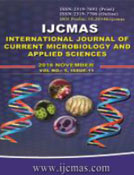


 National Academy of Agricultural Sciences (NAAS)
National Academy of Agricultural Sciences (NAAS)

|
PRINT ISSN : 2319-7692
Online ISSN : 2319-7706 Issues : 12 per year Publisher : Excellent Publishers Email : editorijcmas@gmail.com / submit@ijcmas.com Editor-in-chief: Dr.M.Prakash Index Copernicus ICV 2018: 95.39 NAAS RATING 2020: 5.38 |
Dermatophytosis is one of the most common causes of superficial fungal infections. These organisms colonize the keratin tissues and are restricted to the nonliving cornified layer of the epidermis. This study aims at detection of the rate of incidences of dermatophytic infections (group wise) and etiological agents. To find the Prevalence of dermatophytosis in out patients attending a tertiary care center. Samples from 114 cases of clinically suspected patients of dermatophytosis were collected over a period of six months. Detailed history was taken and thorough clinical examination was done, following which samples were collected and subjected to KOH test and culture using SDA and DTM. Of the 114 samples collected from patients, we found that dermatophytoses is more common in males 75 (65.7%) than females 39 (34.2%).The commonest clinical diagnosis was T. corporis (47%), least common being T. unguim 5%. Of 114 sample, KOH positivity was 68(59.6%) and culture positive was found to be 43(37.7%). Out of 43 samples Trichophyton 32(74.4%), Microsporum 7(16.27) and 4 (9.3%) Epidermophyton were the dermatophytes isolated. Trichophyton rubrum was found to be the commonest infecting species in this study. Young males were more affected and T. corporis is the commonest clinical diagnosis. Dermatophytosis can be prevented by a meticulous personal hygiene. Proper education and personal hygiene will definitely help the population to prevent contracting the infection and in active disease to approach for treatment.
 |
 |
 |
 |
 |